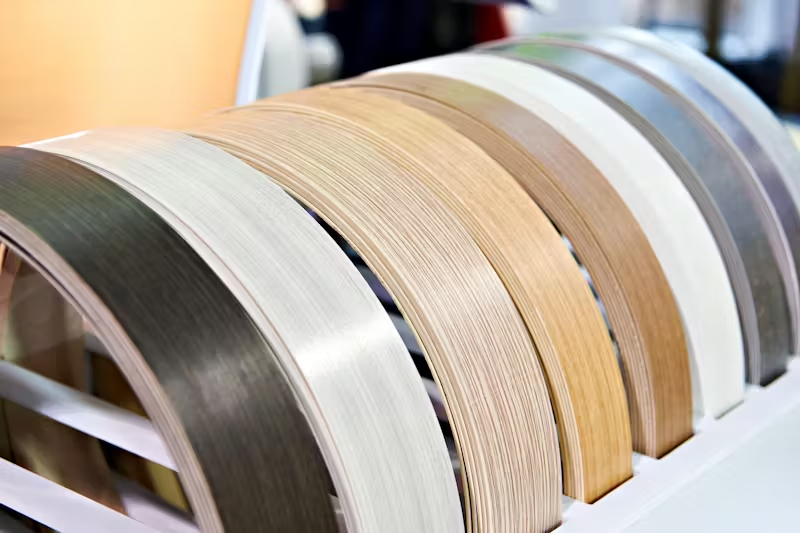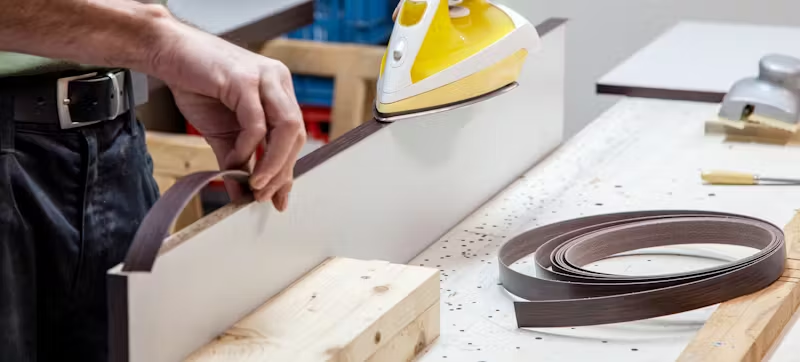When you’re working on a DIY project or installing cabinets with plywood or particle board, there’s one part that should never be overlooked – the rough, unfinished edges. Unfinished edges will make your cabinets look incomplete, but there’s an easy solution: edge banding.
Edge banding is a simple way to cover the rough edges for a clean and seamless look. This guide will break down what edge banding is, the types there are, and how it can give your cabinets a clean, finished touch.
Why Use Edge Banding?

People use edge banding for two reasons: durability and appearance.
Durability: Exposed plywood or particle board edges are more likely to be damaged than finished edges. Raw edges tend to wear down quickly, whether from scrapes, moisture, or anything else. Edge banding will reinforce the edge, making the cabinets stronger and able to withstand daily wear.
Appearance: Unfinished plywood doesn’t look great! Edge banding gives your cabinets a finished and polished look. By matching the color of the edge banding to your cabinet, it will be completely seamless, sleek, and refined. Fabuwood offers matching edge banding for all shelves and Illume cabinet boxes. You can opt for a contrasting edge banding color for a striking, modern look if you're more adventurous.
Types of Edge Banding
The two most common materials for edge banding are PVC and veneer. Fabuwood uses a wood veneer edge band for shelves in Allure and Value cabinets and PVC edge banding for Illume cabinets, Match Interior Shelves and ¾” refrigerator end panels.
PVC is made of thermoplastic resin and is durable yet flexible. It’s widely used for pressure laminated or melamine cabinets. There are many options for color, texture, and wood grains.
Veneer is the best option if you want the look of solid wood. It gives plywood a high-end appearance at a fraction of the cost. A veneer can be stained or painted to match your existing cabinet color.
Choosing the Right Thickness
Edge banding comes in different thicknesses, and the right one depends on its intended use.
.5 mm is the thinnest option, perfect for low use areas or decorative pieces.
1 mm is excellent for high traffic areas like kitchens and bathroom, since it offers more protection against wear and tear.
3 mm is a heavy-duty option used in commercial areas where strength is critical.
Applying Edge Banding: An Easy DIY Project

Applying edge banding is perfect if you love to DIY and want to finish your cabinets beautifully. All you need is an iron (or even a hair dryer), a utility knife, and sandpaper. Here’s a breakdown of how to apply it:
Please note: Fabuwood does not offer this type of edge banding and not all edge bands have an adhesive that can be activated by heat; for those edge bands, you will need to add glue (preferably contact cement glue) to the edge band and panel.
Measure and cut: If the edge banding is a little longer than the edge of the plywood, measure it and trim it to size using a utility knife.
Heat it: Slowly press your iron along the banding on the medium setting so the adhesive activates.
Press it down: Press the adhesive firmly using a wood block to ensure it sticks.
Trim the excess: Trim any excess banding along the edges with the utility knife.
Smooth the edges: Lightly sand the edges with sandpaper to smooth everything out.
Why Edge Banding is a Must
If you’re using plywood in any project, edge banding is an easy way to achieve a polished and finished look. Not only does it protect your cabinets, it transforms them into a refined and high-quality product. With the right materials, you can elevate your DIY game in a few simple steps. To learn more about Fabuwood’s edge banding along with our full line of products, reach out to your local dealer.


